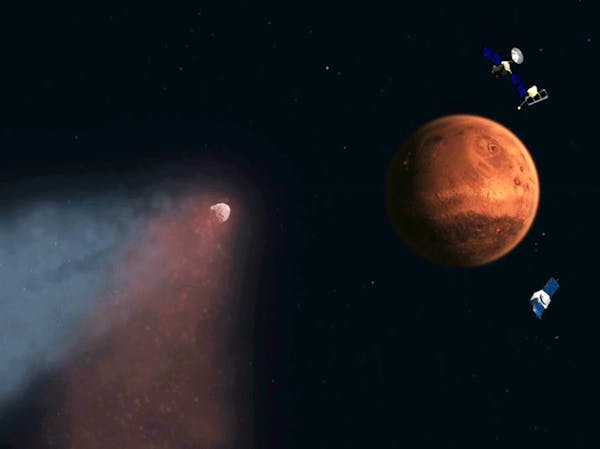From providing clues to evolution — on both land and sea — to offering new perspectives on our modern landscape — whether it's shooting stars of comet dust or the habitat for gray wolves on Earth — scientists are reporting exciting new discoveries that further our understanding about our world.
Researchers say they've found the missing link between an ancient aquatic predator and its ancestors on land. Ichthyosaurs, the dolphin-like reptiles that lived in the sea during the time of the dinosaurs, evolved from terrestrial creatures that made their way back into the water over time.
But the fossil record for the lineage has been spotty, without a clear link between land-based reptiles and the aquatic ichthyosaurs scientists know came after. Now, researchers report in Nature that they've found that link — an amphibious ancestor of the swimming ichthyosaurs named Cartorhynchus lenticarpus.
Lead author Ryosuke Motani, a professor of earth and planetary sciences at the University of California Davis, and his colleagues — who include researchers from Peking University, Anhui Geological Museum, the Chinese Academy of Science, University of Milan and the Field Museum in Chicago — found the fossil in China's Anhui Province in 2011. The creature is about a foot and a half long and lived 248 million years ago. Intense analysis put it smack dab in the middle of the ichthyosaur family. But unlike previously discovered fossils in the lineage, this one wasn't perfectly suited to life in the ocean.
Ocean-bound ichthyosaurs had very long snouts (leading to their frequent comparison to modern dolphins) that were made for capturing fish and squid. This new animal had a shorter snout — more like a land-based reptile. It also had large flippers and flexible wrists, which would have allowed it to flop around on land like a seal. One of the most important differences between this new ichthyosaur and its supposed descendants comes down to being big boned. Their thick bones probably allowed them to fight the power of strong coastal waves and stay grounded in shallow waters.
The animal lived about 4 million years after the worst mass extinction in our planet's history — so Motani and his colleagues believe the creature gives insight into how long it took the ecosystem to recover.
"It was in the tropics, and it was probably a bottom feeder that fed on soft-bodied things like squid and animals like shrimp," Motani said. "And for a predator like that to exist, there has to be plenty of prey. This was probably one of the first predators to appear after that extinction."
Washington post

NASA hears from Voyager 1, the most distant spacecraft from Earth, after months of quiet

The House votes for possible TikTok ban in the US, but don't expect the app to go away anytime soon

Why you should donate clothing: It (probably) won't end up at the dump

Apple pulls WhatsApp and Threads from App Store on Beijing's orders

